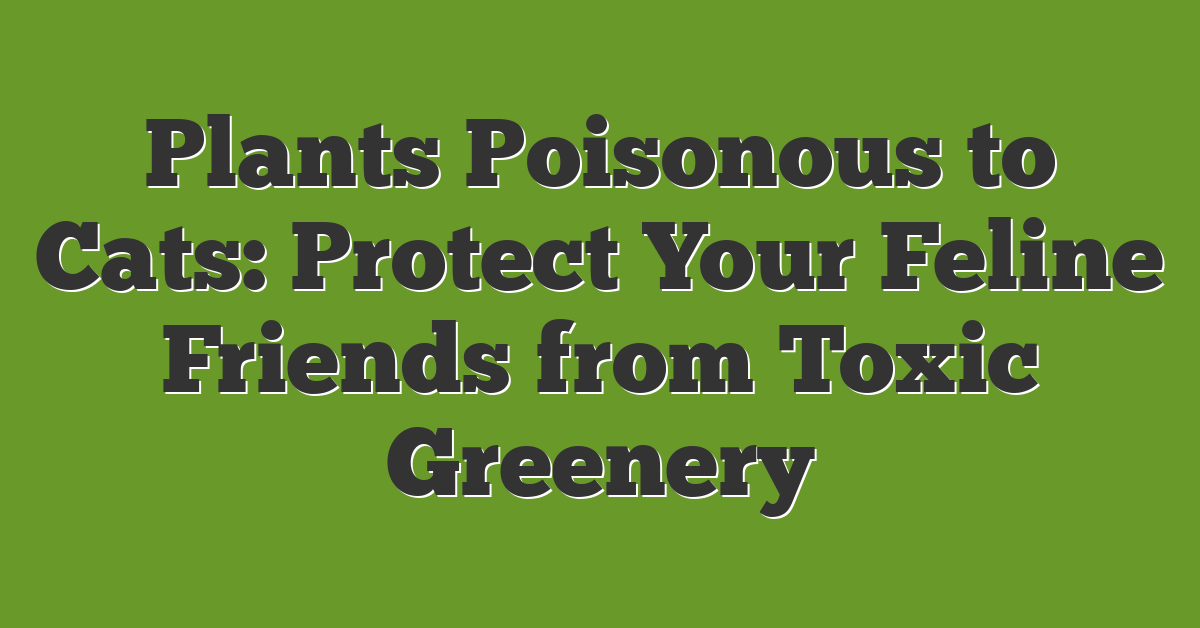Common Plants That Are Poisonous to Cats
As a cat lover, it’s important to be aware of the plants that can be harmful to our furry friends. Cats are curious creatures, and they love exploring their surroundings, including the plants in our homes and gardens. However, some common plants can pose a risk to their health. Here are a few plants you should watch out for:
- Lilies: While lilies are beautiful flowers, they are highly toxic to cats. Ingesting any part of the lily can lead to kidney failure, even in small amounts. Remember to keep lilies out of your cat’s reach, both indoors and outdoors.
- Azaleas and Rhododendrons: These colorful and popular shrubs contain toxins that can cause vomiting, diarrhea, and even more severe symptoms, such as difficulty breathing and abnormal heart rhythm. Be sure to keep your cat away from these plants.
- Sago Palm: This popular indoor plant may be aesthetically pleasing, but its seeds and leaves contain toxins that can be lethal to cats. Symptoms of sago palm poisoning include vomiting, diarrhea, and liver failure. If you have a sago palm, keep it far away from your feline friend.
- Tulips and Daffodils: These springtime favorites can cause gastrointestinal upset in cats. The bulbs of tulips and daffodils are the most toxic parts. If you have these plants, make sure your cat can’t access the bulbs.
- Pothos: Also known as devil’s ivy, pothos is a common houseplant that is toxic to cats. Ingesting its leaves can cause oral irritation, vomiting, and difficulty swallowing. Keep pothos plants away from your cat.
Remember, this list is not exhaustive. There are many other plants that can be harmful to cats. If you suspect that your cat has ingested a toxic plant, contact your veterinarian immediately. To create a safe environment for your feline friend, consider sticking to cat-friendly plants or placing toxic plants out of their reach.
Being aware of common plants that are poisonous to cats is essential in keeping your feline friend safe and healthy. By taking precautions and knowing what plants to avoid, you can create a cat-friendly environment that minimizes the risk of plant-related toxicity.
Symptoms of Plant Poisoning in Cats
If your beloved feline friend has accidentally ingested a toxic plant, it’s important to be aware of the symptoms of plant poisoning in cats. As a cat lover, it’s crucial to recognize these signs so you can take immediate action and seek veterinary help for your furry companion.
Here are some common symptoms of plant poisoning in cats:
- Vomiting: It’s not uncommon for cats to vomit occasionally, but if you notice frequent or persistent vomiting, it could be a sign of plant poisoning.
- Diarrhea: Keep an eye out for loose or watery stools, as this may indicate that your cat has ingested something harmful.
- Loss of Appetite: If your cat suddenly becomes disinterested in their food or stops eating altogether, it could be a red flag for plant poisoning.
- Lethargy: Cats are known for their playful and energetic nature. If you notice a sudden lack of energy or increased sleepiness, it could be a result of plant poisoning.
- Difficulty Breathing: Some toxic plants can cause respiratory distress in cats. If you notice rapid or labored breathing, it’s important to act swiftly.
- Excessive Drooling: Excessive drooling or hypersalivation can be a sign that your cat has ingested a poisonous plant.
- Pawing at the Mouth: If your cat is pawing at their mouth or showing signs of discomfort, it could indicate plant poisoning.
Remember, these symptoms may vary depending on the plant ingested and the severity of the toxicity. It’s crucial to be vigilant and observe any unusual behavior in your cat.
If you suspect that your cat has ingested a toxic plant or if you notice any of these symptoms, don’t hesitate to reach out to your veterinarian immediately. They are the best resource to guide you on what steps to take next for your furry friend’s well-being.
By being aware of the symptoms of plant poisoning in cats, you can act quickly and ensure the best care for your beloved feline companion. So keep an eye out for these signs and remember, prevention is always key when it comes to keeping your cat safe from toxic plants.
First Aid for Plant Poisoning in Cats
If you suspect that your beloved cat has ingested a toxic plant, it’s crucial to act quickly and provide immediate first aid. Remember, every minute matters when it comes to the health and well-being of your furry friend. Here are some steps you can take to help your cat in case of plant poisoning:
- Assess the situation: Start by identifying the plant your cat has come into contact with. Look for any remaining leaves, stems, or flowers to determine the potential toxicity. Remember that some plants may only be harmful if ingested in large quantities.
- Contact a veterinarian: Reach out to your veterinarian immediately and provide them with all the necessary information. Describe the plant your cat has encountered and mention any symptoms you have noticed. Your vet will give you further guidance on how to proceed.
- Flush it out: If your vet recommends it, you may need to induce vomiting in your cat. However, always consult the vet before attempting this as it can be dangerous in certain cases. Do not induce vomiting if your cat is unconscious, having difficulty breathing, or showing signs of distress.
- Stay calm and supportive: While waiting for professional help, provide a calm and comforting environment for your cat. Keep them warm and quiet, away from any potential toxins. Provide fresh water, but do not force your cat to drink. Avoid giving any home remedies or medications without veterinary advice.
Remember, these first aid steps are just temporary measures until you can get your cat the proper veterinary care they need. Never underestimate the importance of seeking professional help as soon as possible. Time is of the essence when it comes to treating plant poisoning in cats.
Preventing Plant Poisoning in Cats
As a cat lover, you want to make sure that your furry friend is safe and healthy at all times. One important aspect of keeping your cat safe is knowing how to prevent plant poisoning. By taking precautions and being aware of the plants that are toxic to cats, you can create a safe environment for your feline companion.
Here are a few tips to help you prevent plant poisoning in cats:
- Do your research: Before bringing a new plant into your home or garden, make sure to research whether it is safe for cats. There are many common plants, such as lilies, tulips, and daffodils, that can be toxic to cats if ingested. Knowing which plants to avoid can make a big difference in keeping your cat safe.
- Keep plants out of reach: Cats are naturally curious and love to explore their surroundings. To prevent your cat from nibbling on plants that may be toxic, keep them out of their reach. Consider placing your plants on high shelves or using hanging planters to keep them away from your curious feline.
- Create a kitty-friendly garden: If you have an outdoor space, you can create a separate area where your cat can roam freely without the risk of exposure to toxic plants. Plant cat-friendly herbs like catnip and cat grass, which can be enjoyable and safe for your feline companion to nibble on.
- Supervise outdoor time: When your cat is outdoors, keep a close eye on them to ensure they don’t come into contact with any toxic plants that may be in your yard or neighborhood. Supervision is key to preventing plant poisoning incidents.
Remember, prevention is the key to keeping your cat safe from plant poisoning. By taking these simple steps, you can create a safe environment for your beloved feline friend to explore and enjoy without any risks.
So, as a responsible cat owner, take the necessary precautions and be proactive in preventing plant poisoning. Your cat’s health and well-being depend on it.
Conclusion
By taking the necessary precautions, you can ensure that your furry friend stays safe from plant poisoning. Remember to always research plants before bringing them into your home or garden. This simple step can save you and your cat from potential harm. Additionally, keeping plants out of your cat’s reach is crucial. Consider placing them on high shelves or using hanging baskets to prevent any curious nibbling.
Creating a kitty-friendly garden is another great way to protect your cat. Include safe plants and provide alternative options, such as cat grass, for them to enjoy. Lastly, don’t forget to supervise your cat during outdoor time. This will allow you to intervene if they come across any potentially toxic plants.
Prevention is key when it comes to keeping your cat safe from plant poisoning. With a little bit of research and some careful planning, you can create a safe environment that both you and your feline companion can enjoy. So, take the necessary steps today and give your cat the protection they deserve.
Frequently Asked Questions
Q: Why is it important to prevent plant poisoning in cats?
Preventing plant poisoning in cats is essential because many common plants are toxic to them. Ingestion of these plants can lead to serious health issues and even be fatal for cats. By taking preventative measures, cat owners can ensure their feline friends stay safe and healthy.
Q: How can I create a safe environment for my cat?
Creating a safe environment for your cat involves researching plants before bringing them into your home or garden. Remove any toxic plants from your cat’s reach and opt for cat-friendly alternatives instead. Additionally, designating a kitty-friendly garden and supervising your cat’s outdoor time can further enhance their safety.
Q: What should I do if I suspect my cat has ingested a poisonous plant?
If you suspect your cat has ingested a poisonous plant, it’s crucial to seek immediate veterinary assistance. Even if your cat is not showing symptoms, contacting your veterinarian will help determine the necessary course of action and potentially save your cat’s life. Do not attempt to induce vomiting or administer any home remedies without professional guidance.

















